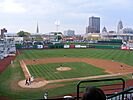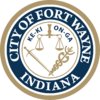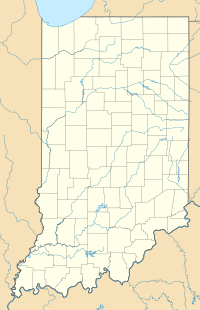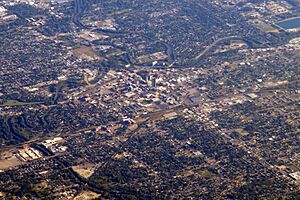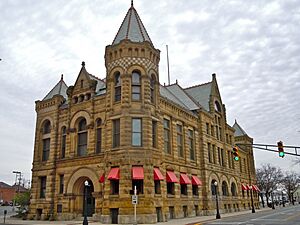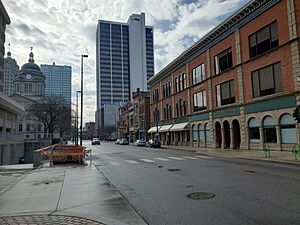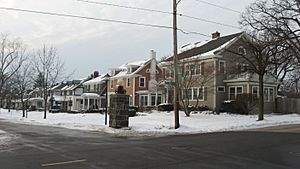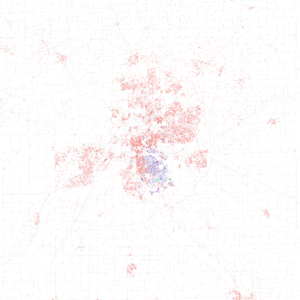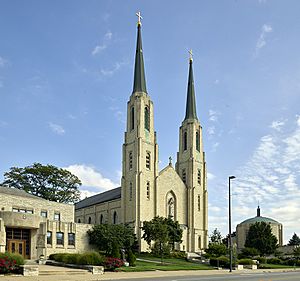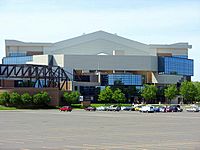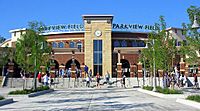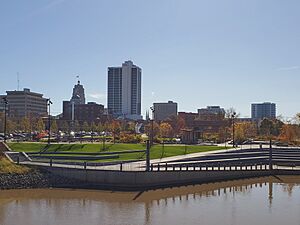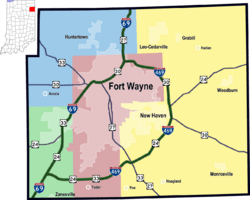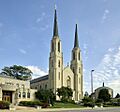Fort Wayne, Indiana facts for kids
Quick facts for kids
Fort Wayne
|
|||
|---|---|---|---|
|
|
|||
|
|||
| Nickname(s):
"Summit City"; "City of Churches"; "City That Saved Itself"; "Magnet Wire Capital of the World"
|
|||
| Motto(s): | |||
| Country | |||
| State | |||
| County | Allen | ||
| Townships | Aboite, Adams, Perry, Pleasant, St. Joseph, Washington, Wayne | ||
| Founding | October 22, 1794 | ||
| Incorporated (town) | January 3, 1829 | ||
| Incorporated (city) | February 22, 1840 | ||
| Founded by | Jean François Hamtramck | ||
| Named for | Anthony Wayne | ||
| Government | |||
| • Type | Mayor–council | ||
| Area | |||
| • City | 110.79 sq mi (286.95 km2) | ||
| • Land | 110.57 sq mi (286.38 km2) | ||
| • Water | 0.22 sq mi (0.56 km2) | ||
| • Urban | 135.25 sq mi (350.3 km2) | ||
| • Metro | 1,368 sq mi (3,540 km2) | ||
| Elevation | 758 ft (231 m) | ||
| Population
(2020)
|
|||
| • City | 265,974 | ||
| • Rank | 1st in Allen County 1st in Northern Indiana 2nd in Indiana 83rd in United States |
||
| • Density | 2,400.70/sq mi (926.900/km2) | ||
| • Urban | 335,934 (US: 121st) | ||
| • Urban density | 2,053.4/sq mi (792.8/km2) | ||
| • Metro | 423,038 (US: 130th) | ||
| • CSA | 649,105 (US: 79th) | ||
| Demonym(s) | Fort Wayner | ||
| Time zone | UTC−05:00 (EST) | ||
| • Summer (DST) | UTC−04:00 (EDT) | ||
| ZIP Codes |
ZIP codes
46802–46809, 46814–46816, 46818, 46819, 46825, 46835, 46845, 46850
|
||
| Area code(s) | 260 | ||
| FIPS code | 18-25000 | ||
| GNIS feature ID | 2394798 | ||
Fort Wayne is a city in northeastern Indiana, USA. It is the county seat of Allen County. The city is about 18 miles (29 km) west of the Ohio border and 50 miles (80 km) south of the Michigan border.
In 2020, Fort Wayne had a population of 263,886 people. This makes it the second-largest city in Indiana, right after Indianapolis. It is also the 83rd most populated city in the entire United States. Fort Wayne is the main city of a larger area called the Fort Wayne metropolitan area, which has about 423,038 people. It's a key place for culture and business in northeastern Indiana.
The city is named after Anthony Wayne, an American Revolutionary War general. He built a fort here in 1794. This fort was the last in a series of forts built near the Miami village of Kekionga. The city grew where the St. Joseph, St. Marys, and Maumee rivers meet. This spot was first a trading post called Fort Miami, built around 1706.
Fort Wayne grew a lot after the War of 1812 and when the Wabash and Erie Canal and railroads were built. It used to be a big manufacturing city. Today, its economy focuses on shipping, healthcare, business services, and financial services. Fort Wayne has won the All-America City Award four times (1983, 1998, 2009, and 2021).
Contents
History of Fort Wayne
Early Beginnings: Native Americans and French Settlers
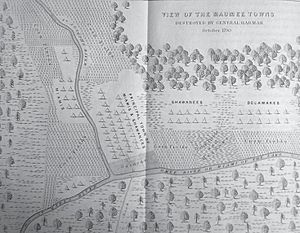
For thousands of years, different groups of indigenous peoples lived in the area where Fort Wayne is now. Around the 1690s, the Miami tribe built their main village, Kekionga, at the meeting point of the Maumee, St. Joseph, and St. Marys rivers. This spot was very important to the Miami and other Algonquian tribes.
In 1706, a French explorer named Jean Baptiste Bissot, Sieur de Vincennes built a small trading post here called Fort Miami. It was part of a chain of forts built by New France to help with trade. By 1744, about 40 French people and 1,000 Miamians lived there.
British Control and Native American Resistance
In 1760, France gave control of the area to Britain after a war. But in 1763, Native American groups, led by Pontiac's Rebellion, took the fort back. For the next 30 years, there was no active fort at Kekionga. It became a mix of Native American warriors and traders.
In 1772, the British tried to regain influence. During the American Revolutionary War, the British kept an eye on Kekionga. In 1783, after the war, Britain gave this land to the new United States. However, they still tried to control trade and slow down American expansion.
The Northwest Indian War and Fort Wayne's Founding
American settlers began moving into the area, which led to conflicts with a group of Native American tribes called the Western Confederacy. This group was based at Kekionga. They wanted to stop settlers from taking their land.
In 1790, President George Washington sent the U.S. Army to deal with the tribes. The first army, led by General Josiah Harmar, burned Kekionga. But the Miami war chief Little Turtle quickly forced Harmar's troops to leave. A second army, led by General Arthur St. Clair, was defeated in 1791 in a huge loss for the U.S. Army.
General Anthony Wayne then led a third expedition. His forces defeated the Native American warriors at the Battle of Fallen Timbers in 1794. Wayne's men then marched to Kekionga, which was in ruins. He chose this spot to build a strong fort that could stand against attacks. This new fort was named Fort Wayne in his honor.
The next year, Wayne signed the Treaty of Greenville with tribal leaders. This treaty ended the fighting and gave the U.S. control over much of what is now Ohio and some land further west, including the area around Fort Wayne.
Growth of the City
The first permanent settlement began in 1815. In 1822, land offices opened to sell land that Native Americans had given up in the Treaty of St. Mary's in 1818. Fort Wayne became an important frontier town and was officially made a town in 1829. It had about 300 people then.
The opening of the Wabash and Erie Canal greatly improved travel and trade, connecting Fort Wayne to the Great Lakes and Mississippi River. This brought many new chances for business. By 1840, the population grew to over 2,000, and Fort Wayne became a city.
The city's nickname, "Summit City," comes from this time. It means Fort Wayne was at the highest point along the canal's path. The canal soon became less important when the first railroad arrived in 1854.
Modern Fort Wayne: Challenges and Comebacks
By the early 1900s, Fort Wayne's population reached almost 50,000, thanks to many German and Irish immigrants. The city became a busy manufacturing hub. Many important inventions came from Fort Wayne, like gasoline pumps (1885), the refrigerator (1913), and even the first home video game console (1972).
In 1913, a huge flood caused seven deaths and left 15,000 people without homes. It was the worst natural disaster in the city's history. As cars became popular, Fort Wayne became a key stop on the Lincoln Highway. The city's first airport, Smith Field, opened in 1919.
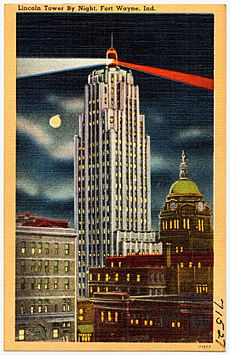
The Great Depression in 1929 hit Fort Wayne hard, with many factories cutting jobs. But the city still built its first skyscraper, the Lincoln Bank Tower, which was Indiana's tallest building at the time. By 1935, government programs helped over 7,000 people get back to work by building new parks, bridges, and a sewage treatment plant.
After World War II, Fort Wayne boomed again. Many new homes were built, and the city's first bypass, Coliseum Boulevard, opened in 1950. The War Memorial Coliseum was built, and it was home to the NBA's Fort Wayne Pistons from 1952 to 1957.
In the 1980s, like many cities in the Rust Belt, Fort Wayne faced tough times as factories closed. This led to job losses and urban problems. A flood in 1982 forced 9,000 residents to leave their homes and caused $56.1 million in damage.
However, in the 1990s, the city started to recover. Leaders worked to reduce crime and bring in new types of businesses. Downtown areas were redeveloped, creating new public spaces like Headwaters Park. Fort Wayne celebrated its 200th birthday in 1994.
The city continued to focus on downtown improvements in the 2000s. Major buildings like the Allen County Public Library and Grand Wayne Convention Center were renovated. In 2007, the Harrison Square project created Parkview Field, a new baseball stadium.
Geography and Environment
Fort Wayne is in the Midwestern United States, in northeastern Indiana. It is 18 miles (29 km) west of Ohio and 50 miles (80 km) south of Michigan. The city covers about 110.8 square miles (287.1 km²), with most of it being land.
Land Features and Rivers
Fort Wayne is mostly flat because of ancient glaciers that smoothed the land. The most special land feature is Cedar Creek Canyon to the north. The city's three rivers, the St. Marys and St. Joseph, meet to form the Maumee. The Maumee River then flows into Lake Erie.
Fort Wayne is located on the Saint Lawrence River Divide. This is a natural boundary that separates water flowing to the Great Lakes Basin from water flowing to the Gulf of Mexico. The short distance between these river systems made Fort Wayne a very important "portage" or carrying place for travelers and traders for thousands of years.
Fort Wayne has a lot of trees, with 29 percent of the city covered by tree canopy. This is much higher than the state average. The city has been named a Tree City USA since 1990.
City Layout and Buildings
Fort Wayne is divided into four main areas: northeast, northwest, southeast, and southwest. These areas are separated by streets and rivers.
In the early 1900s, Fort Wayne developed a special plan for its parks and boulevards. This plan connected the city's three rivers and many neighborhoods with green spaces. Many of these parks were designed by famous landscape architects. In 2010, the Fort Wayne Park and Boulevard System was added to the National Register of Historic Places.
Cool Architecture in Fort Wayne
Fort Wayne has many different styles of buildings. In the 1800s, popular styles included Greek Revival, Gothic Revival, and Italianate architecture. You can still see Greek Revival in the Richardville House (1827). Many churches, like the Cathedral of the Immaculate Conception (1860), show off Gothic styles.
In the early 1900s, styles like Queen Anne, Richardsonian Romanesque, and Art Deco became popular. The Fort Wayne City Hall (1893) is a great example of Richardsonian Romanesque. The Lincoln Bank Tower (1930) is an Art Deco skyscraper that was the tallest building in Indiana for many years.
More modern buildings from the second half of the 1900s show Modern and Postmodern architecture styles. The John D. Haynes House (1952) was designed by the famous architect Frank Lloyd Wright. The Arts United Center (1973) was designed to look like a violin and its case. The Indiana Michigan Power Center (1982) is the tallest building in Fort Wayne today.
Climate and Weather
Fort Wayne has four distinct seasons: hot, humid summers and cold, snowy winters. The city gets about 38.34 inches (97.4 cm) of rain each year and about 33.5 inches (85 cm) of snow.
The highest temperature ever recorded in Fort Wayne was 106°F (41.1°C) on June 28, 2012. The lowest was -24°F (-31.1°C) on January 12, 1918.
Severe weather, like thunderstorms and tornadoes, can happen in Fort Wayne, especially in spring and summer. The city has experienced several tornadoes throughout its history.
People and Culture
| Historical population | |||
|---|---|---|---|
| Census | Pop. | %± | |
| 1850 | 4,282 | — | |
| 1860 | 7,000 | 63.5% | |
| 1870 | 17,718 | 153.1% | |
| 1880 | 26,880 | 51.7% | |
| 1890 | 35,393 | 31.7% | |
| 1900 | 45,115 | 27.5% | |
| 1910 | 63,933 | 41.7% | |
| 1920 | 86,549 | 35.4% | |
| 1930 | 114,946 | 32.8% | |
| 1940 | 118,410 | 3.0% | |
| 1950 | 133,607 | 12.8% | |
| 1960 | 161,776 | 21.1% | |
| 1970 | 178,269 | 10.2% | |
| 1980 | 172,196 | −3.4% | |
| 1990 | 173,072 | 0.5% | |
| 2000 | 205,727 | 18.9% | |
| 2010 | 253,691 | 23.3% | |
| 2020 | 263,886 | 4.0% | |
| 2023 (est.) | 269,994 | 6.4% | |
| U.S. Decennial Census 2010-2020 | |||
Fort Wayne is the main city of the Fort Wayne metropolitan area, which includes Allen and Whitley counties. This area had an estimated population of 423,038 in 2021. A larger area, the Combined Statistical Area, includes several more counties and had about 649,105 people in 2021.
Who Lives in Fort Wayne?
| Race / Ethnicity (NH = Non-Hispanic) | Pop 2000 | Pop 2010 | Pop 2020 | % 2000 | % 2010 | % 2020 | Change 2010–2020 |
|---|---|---|---|---|---|---|---|
| White alone (NH) | 150,368 | 178,436 | 165,865 | 73.09% | 70.34% | 62.85% | -7.49% |
| Black or African American alone (NH) | 35,391 | 38,514 | 39,560 | 17.20% | 15.18% | 14.99% | -.19% |
| Native American or Alaska Native alone (NH) | 653 | 730 | 627 | 0.32% | 0.29% | 0.24% | -.05% |
| Asian alone (NH) | 3,156 | 8,279 | 15,229 | 1.53% | 3.26% | 5.77% | +2.51% |
| Pacific Islander alone (NH) | 73 | 91 | 108 | 0.04% | 0.04% | 0.04% | - |
| Some Other Race alone (NH) | 470 | 542 | 1,517 | 0.23% | 0.21% | 0.57% | +.36% |
| Mixed Race or Multi-Racial (NH) | 3,732 | 6,899 | 13,084 | 1.81% | 2.72% | 4.96% | +2.24% |
| Hispanic or Latino (any race) | 11,884 | 20,200 | 27,896 | 5.78% | 7.96% | 10.57% | +2.61% |
| Total | 205,727 | 253,691 | 263,886 | 100.00% | 100.00% | 100.00% | - |
In 2010, Fort Wayne had 253,691 people. The city is home to a diverse population. About 73.6% were White, 15.4% Black or African American, and 3.3% Asian. A growing number of people are of Hispanic or Latino background, making up about 8% of the population.
Fort Wayne has one of the largest Burmese American populations in the U.S., with an estimated 8,000 people. This has helped the city's Asian population grow a lot.
Religion in Fort Wayne
Fort Wayne is sometimes called the "City of Churches." This nickname started in the late 1800s because it was a big center for Catholic, Lutheran, and Episcopal faiths. Today, there are 360 churches in the city.
About 54 percent of Fort Wayne residents say they are religious. Many are Christian, including Catholics, Lutherans, Baptists, and Methodists. There are also smaller groups of Jewish, Buddhist, Hindu, and Muslim residents. In 2013, the first Burmese Muslim mosque in the world since the 1970s began construction here.
Economy and Jobs
In 2017, the Fort Wayne area produced $25.7 billion in goods and services. The top industries were manufacturing, healthcare, retail, and finance.
Manufacturing has always been a big part of Fort Wayne's economy. In the early 1900s, the city's factories grew a lot. Companies made things like refrigerators, washing machines, televisions, and car parts. Fort Wayne was especially known for making Magnet wire, supplying almost 90 percent of North America's market in 1960.
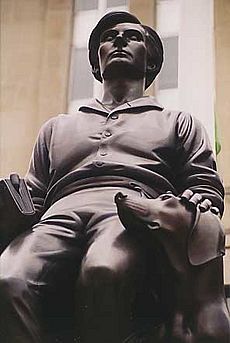
The 1970s and 1980s were tough for Fort Wayne. Many factories closed, and the city lost a lot of manufacturing jobs. This was part of a larger problem in the "Rust Belt" region. However, the arrival of General Motors in 1987 helped the city recover. Today, General Motors is the largest manufacturer in the city, making pickup trucks.
Since the 1990s, Fort Wayne has worked to have a more diverse economy. Besides manufacturing, other important job areas include shipping, healthcare, business services, and tourism. The city is also a center for the defense industry, with thousands of people working for companies like BAE Systems and Raytheon Technologies.

Some big companies based in Fort Wayne include Do it Best, Franklin Electric, and Steel Dynamics. Steel Dynamics is the only Fortune 500 company headquartered here. Other major employers are Parkview Health, Amazon, and Lincoln Financial Group. In 2024, Google announced plans to build a data center in Fort Wayne, bringing new tech jobs.
Culture and Fun
Performing Arts and Entertainment
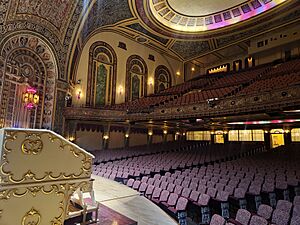
The Embassy Theatre is a beautiful old movie palace that now hosts live shows. It has 2,471 seats and welcomes over 200,000 visitors each year. The Fort Wayne Philharmonic Orchestra often performs here.
The Arts Campus Fort Wayne is home to many cultural groups. These include the Fort Wayne Museum of Art, the Fort Wayne Civic Theater, and the Fort Wayne Dance Collective. The Arts United Center is a special building designed by famous architect Louis Kahn to look like a violin.
Foellinger Theatre is an outdoor amphitheater in Franke Park that hosts concerts in the warmer months. There's also the Arena Dinner Theatre, which puts on live plays.
Top Attractions to Visit
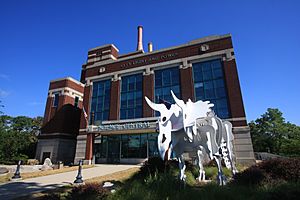
The Fort Wayne Children's Zoo is known as one of the best zoos in the country. It covers 40 acres (16 ha) and has 1,000 animals from 200 different species. Over 500,000 people visit it every year!
The Foellinger-Freimann Botanical Conservatory has beautiful indoor gardens with over 1,200 plants. Science Central is an interactive science museum with fun exhibits that attract 130,000 visitors annually.
The Fort Wayne Museum of Art (FWMoA), founded in 1921, focuses on American art. The History Center, located in the Old City Hall, has over 23,000 items that tell the story of the region. You can also visit Historic Fort Wayne, a replica of the 1815 fort, for tours and reenactments.
The Allen County Public Library is one of the largest public library systems in the U.S. Its genealogy department has the second-largest collection of family history research materials in North America.
Festivals and Events
Fort Wayne hosts many fun festivals and events throughout the year. There are festivals celebrating different cultures with food, dance, music, and art, like Germanfest and Greek Festival. Fort Wayne Pride celebrates the LGBTQ community.
The Johnny Appleseed Festival is one of the biggest events, attracting 300,000 visitors. It's held at Johnny Appleseed Park, where the legendary John Chapman is believed to be buried. The festival features apple-themed foods, crafts, and historical demonstrations.
The Three Rivers Festival is a nine-day celebration of Fort Wayne each July, drawing 400,000 visitors. It has over 200 events, including a parade, a carnival, a hot dog eating contest, and fireworks. Other annual events include the Allen County Fair and the Vera Bradley Outlet Sale.
Sports in Fort Wayne
Fort Wayne has two professional minor league sports teams:
- The Fort Wayne Komets play ECHL hockey.
- The Fort Wayne TinCaps play High-A Central baseball.
The city is also home to Fort Wayne FC, a pre-professional soccer club. The main sports venues are the Allen County War Memorial Coliseum and Parkview Field.
Fort Wayne has been home to other professional teams in the past, including the National Basketball Association's Fort Wayne Pistons (who moved to Detroit in 1957).
Some cool sports facts about Fort Wayne:
- On June 2, 1883, Fort Wayne hosted one of the first baseball games ever played under lights.
- Fort Wayne is considered the birthplace of the NBA. In 1948, the merger of two basketball leagues happened here.
- On March 10, 1961, Wilt Chamberlain became the first NBA player to score 3,000 points in a single season while playing at the War Memorial Coliseum.
Parks and Outdoor Fun
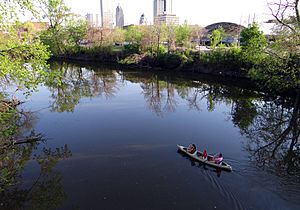
Fort Wayne Parks and Recreation manages 86 public parks, covering over 2,805 acres (1,135 ha). There are also many golf courses in Allen County.
Some important parks include:
- Johnny Appleseed Park: Home to a campground and the grave of John Chapman.
- McCulloch Park: Where Samuel Bigger is buried.
- Old Fort Park: The oldest park in Fort Wayne, located at the site of the original fort.
Downtown parks include the Foellinger-Freimann Botanical Conservatory, Headwaters Park, and Promenade Park. Franke Park is the largest city park, covering 339.24 acres (137.3 ha). It's home to the Foellinger Theatre and the Fort Wayne Children's Zoo.
Since the 1970s, Fort Wayne has developed a system of trails along its rivers called the Rivergreenway. These trails are great for walking, running, and biking. The Rivergreenway was named a National Recreation Trail in 2009. By 2018, it had grown to almost 180 miles (290 km) of trails.
Cycling has become a popular way to get around. In 2009, the city added its first bicycle lanes. In 2016, Fort Wayne was recognized as a "Bronze Level bicycle friendly community."
Hurshtown Reservoir, near Grabill, is the largest body of water in Allen County. It's a popular spot for sailing and fishing. You can also rent canoes, kayaks, and pontoon boats to explore Fort Wayne's three rivers.
Education and Learning
Schools for Kids and Teens
Four public school districts serve different parts of Fort Wayne. Fort Wayne Community Schools (FWCS) is the largest public school district in Indiana. It has nearly 31,000 students and 51 schools, including elementary, middle, and high schools. Students in FWCS speak 75 different languages!
Other public school districts include East Allen County Schools (EACS), Northwest Allen County Schools (NACS), and Southwest Allen County Schools (SACS). Private schools are also available, many run by Lutheran and Catholic organizations.
Colleges and Universities

Fort Wayne has campuses connected to Indiana's main state university systems. Indiana University Fort Wayne (IU Fort Wayne) focuses on health sciences. Purdue University Fort Wayne (PFW) offers many other degree programs. These two universities were formed in 2018 from a single older institution.
Ivy Tech also has two campuses in the city, offering community college programs.
There are three private universities in Fort Wayne:
- Concordia Theological Seminary: The oldest higher education school in the city, founded in 1846.
- Indiana Tech: Founded in 1930, with about 3,900 students.
- University of Saint Francis: A Catholic university established in 1890.
Media and News
Fort Wayne has several TV stations, including WANE-TV (CBS), WPTA-TV (ABC/NBC), and WFFT-TV (Fox). WFWA-TV is the local PBS station. There is also a National Public Radio station, WBOI.
The city has two main newspapers: Journal Gazette and the News-Sentinel. They have separate news teams, but they share printing and advertising services. In 2017, the News-Sentinel stopped printing paper copies and became a digital-only newspaper.
City Services and Transportation
Getting Around Fort Wayne
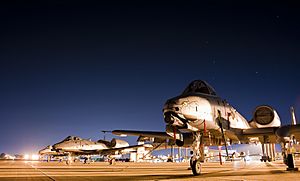
Fort Wayne has two airports. Fort Wayne International Airport (FWA) is the main airport for commercial flights. It's Indiana's second busiest airport. Smith Field is used for smaller, private planes.
The city is served by Interstate 69 (I-69), a major highway that runs north and will eventually extend south to the U.S.-Mexico border. There's also a beltway, Interstate 469, that goes around the city. Many U.S. Routes and Indiana State Roads also meet in Fort Wayne.
Most people in Fort Wayne drive their own cars to work. Unlike many cities its size, Fort Wayne does not have a freeway system running through its downtown. In the past, plans for a downtown freeway were voted down by residents.
For train travel, the closest Amtrak passenger train station is about 25 miles (40 km) north in Waterloo. There's a movement to bring direct passenger train service back to Fort Wayne. Freight trains still use the city's rail lines.
Citilink operates the city's public bus system, with routes throughout Fort Wayne and New Haven. In 2016, the city started its first bike-sharing program, making it easier to rent bicycles.
Healthcare and Utilities
Healthcare in Fort Wayne is mainly provided by two large healthcare systems: Parkview Health and Lutheran Health Network. They operate several hospitals, including Dupont Hospital and Parkview Regional Medical Center. These systems are among the city's largest employers.
City Utilities provides water to residents from the St. Joseph River. They also manage the city's sewer system. Electricity is provided by Indiana Michigan Power, and natural gas by NIPSCO. The city also offers curbside recycling and trash collection.
Sister Cities
Fort Wayne has special connections with cities around the world, called sister cities:
 Takaoka, Japan (since 1977)
Takaoka, Japan (since 1977) Płock, Poland (since 1990)
Płock, Poland (since 1990) Gera, Germany (since 1992)
Gera, Germany (since 1992) Taizhou, China (since 2012)
Taizhou, China (since 2012)
Friendship city
Images for kids
-
An illustrated 1789 map of Kekionga
-
Lincoln Bank Tower, completed as Indiana's tallest building, in 1930
-
Abraham Lincoln: The Hoosier Youth stands in front of Lincoln Financial Group's downtown offices.
-
Do it Best corporate headquarters at Electric Works. In 2022, Do it Best was the largest privately held company in the state of Indiana, with US$5.5 billion in revenue.
-
The Embassy Theatre opened in 1928 as a movie palace.
-
Science Central opened in the city's former municipal power plant in 1995.
-
Fort Wayne style Coney Island hot dogs, developed in 1914 by Macedonian immigrants in the city
-
Canoeing on the St. Marys River
-
Kramer Chapel on the Concordia Theological Seminary campus
-
An A-10 Warthog after completing a training mission at the Fort Wayne Air National Guard Station
-
John Chapman's grave in Johnny Appleseed Park
See also
 In Spanish: Fort Wayne para niños
In Spanish: Fort Wayne para niños






